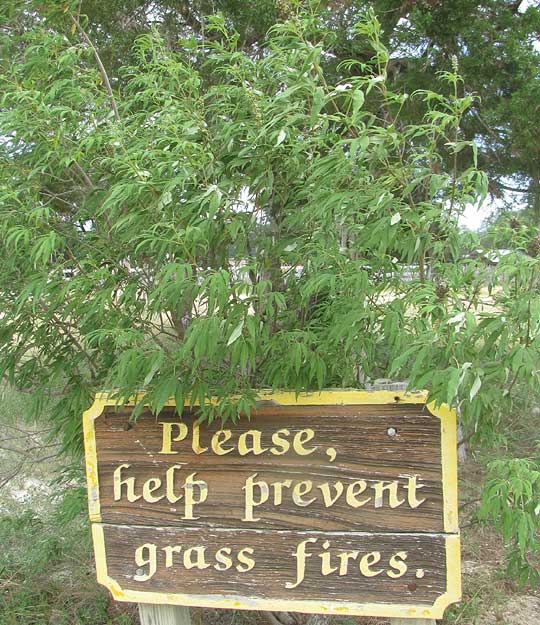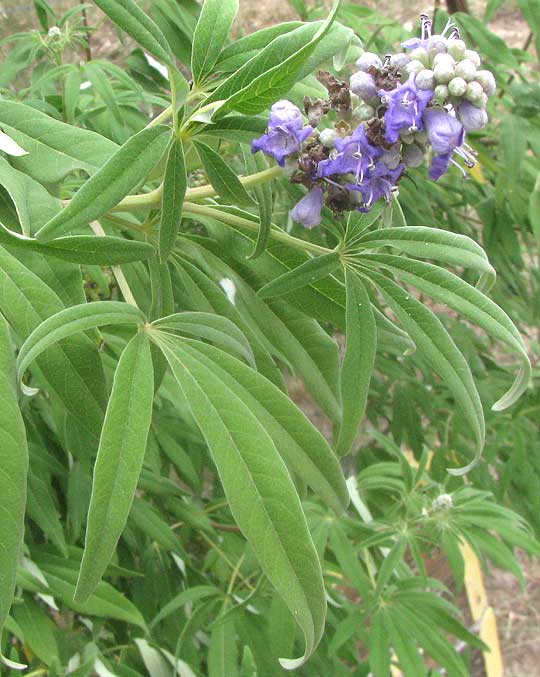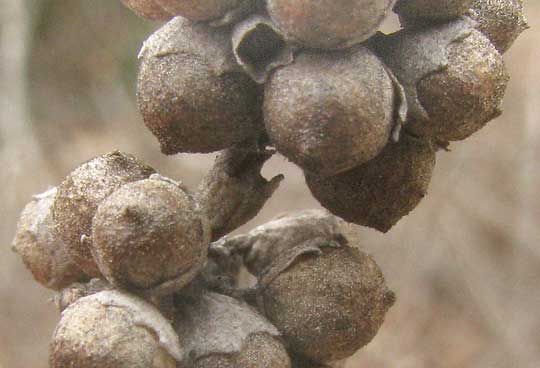Excerpts from Jim Conrad's
Naturalist Newsletter
from the August 4, 2013 Newsletter issued from the Frio Canyon Nature Education Center in the valley of the Dry Frio River in northern Uvalde County, southwestern Texas, on the southern border of the Edwards Plateau; elevation ~1750m (~5750 ft); N29.62°, W99.86°; USA
HEMPTREE
More than one visitor to the little community in the Dry Frio Valley below the Center has done a double-take while passing by the sign shown below:

The reason is the bush growing immediately behind the sign. A close-up of some leaves on a growing stem of that bush is shown below:

The other day my neighbor Phred brought me such a leafy branch saying that it was growing at JW's place, and JW said that on his friend's farm in Idaho this stuff grew all along his fences, and JW said it was Marijuana.
But, if you know what Marijuana leaves look like, you know that this isn't Marijuana. Most obviously, Marijuana leaflet margins are serrated with many low, forward projecting, saw-like teeth, but these leaflets bear no teeth at all. Also, Marijuana's upper stem leaves arise singly per stem node (they're alternate) while this bush's compound leaves occur two per node (opposite). And if that isn't enough, everyone knows that Marijuana doesn't produce purple flowers, which this shrub does, as shown below:

Flower close-ups show that the lilac-colored flowers with their five corolla lobes are very slightly bilaterally symmetrical, with four stamens arranged in pairs of different lengths, as you can see below:

In other words, these flowers are very similar to Mint-Family flowers. However, Mint Family species don't have compound leaves like this bush, and this bush's stem is round in cross-section, not square, as are the mints'. This plant belongs to a family parked next to the Mint Family on the Phylogenetic Tree of Life: the Vervain or Verbena Family, the Verbenaceae. The plant is VITEX AGNUS-CASTUS, so well known throughout the world that it goes by many names, including Chaste-Tree, Chasteberry, Abraham's Balm, Monks Pepper-Tree, and, of course, Hemp-Tree. In this area Hemp-Tree makes the most sense.
But, long before people started talking about Marijuana, the Hemp-Tree was famous as an anaphrodisiac (opposite of an aphrodisiac). Pliny, in his Historia Naturalis of circa AD 77-79 reports the use by women of the plant's stems and leaves as bedding "to cool the heat of lust" during those periods when fooling around wasn't permitted because of religious festivals -- thus the names Chaste-Tree and Chasteberry.
Actually, there may have been something to that use. Modern studies show that at low doses extracts of the plant inhibit activation of the dopamine 2 receptor, causing a slight increase in release of prolactin, which can influence levels of estrogen in women and testosterone in men. In fact, nowadays certain herbal remedies on the market use Hemp-Tree/Chastetree for menstrual cycle problems and in combination with other herbs for certain hormone imbalances.
Hemp-Tree is a native of the Mediterranean region, but has escaped into the landscape across the southern half of the US, and in many other countries as well.
from the March 16, 2014 Newsletter issued from the Frio Canyon Nature Education Center in the valley of the Dry Frio River in northern Uvalde County, southwestern Texas, on the southern border of the Edwards Plateau; elevation ~1750m (~5750 ft); N29.62°, W99.86°; USA
HEMP-TREE FRUITS
Not far upstream from the escaped Oleander yet another escapee caught my eye. This one also was bushy but was much less robust, leafless, and consisted of only a few stiff, slender, brown stems tipped with brown, peppercorn-like fruits, shown below:

The plant's leaves, like its secondary stems, arose two per node, or "opposite," which for the identification process eliminated most possibilities, because one leaf per node, or "alternate," is a little more typical. The plant's general aspect and its opposite leaves directed me to that region of the Phylogenetic Tree of Life graced by the big branches of the Mint and Verbena Families. So, what plants have I found around here in those families, and who could have produced these fruits? A closer look at the hard, spherical fruits curiously surrounded at their bases by unusually large, close-fitting, bowl-like calyxes is shown below:

One possibility was the Whitebrush, of the Verbena Family, but it's hard to imagine that bush's small flowers with their slender, curved tubes producing such substantial fruits with bowl-shaped calyxes. The same was true of the Shrubby Blue Sage of the Mint Family. Another possibility was the Hemp-Tree, or Chaste-Tree, of the Verbena Family, and the more I thought of that possibility the more I liked it, for it seemed that I remembered that bush's calyxes cupping the blue flowers' bases as they do on these fruits. {see top entry}.
Back at Juniper House an image search on Hemp-Tree fruits scored a perfect match. So, Hemp-Tree, or Chaste-Tree, VITEX AGNUS-CASTUS, a native of the Mediterranean region, but which has escaped into the landscape across the southern half of the US, and in many other countries as well.
During the search for pictures of Hemp-Tree fruits, several pages turned up selling herbal medicines concocted of fruits and leaves of the plant. The HerbFacts.co.UK website claims that the plant "has been used in herbal medicine for centuries to relieve symptoms associated with female hormonal imbalances such as menstrual cramps, mood swings and water retention."
On the Vitacost.com website, which sells 90 capsules for $3.99, users have posted comments. Two women say that the capsules did nothing to stop their hot flashes, but another says it did, and another writes, "My PMS is GONE," continuing to say that the capsules must be taken regularly in order to work.